
The types of worms that infect a person's internal organs are called helminths. According to statistics, today about 30% of the total population is susceptible to helminthic invasion. Worms that poison the body can infect any part of the body. This is dangerous not only for diseases that can provoke helminths. Their presence in the body can be fatal.
To date, helminthiasis can be completely cured not only with medication but also with folk remedies. Each type has its own treatment methods. Therefore, it is worth knowing and understanding what are the types of worms as well as the symptoms of a parasitic infection, in order to take timely measures.
Classification of helminthiasis
Parasitic worms are divided into two major groups: intestines and tissues.
The first species live directly in the gut. This group includes:
- roundworms and worms;
- worms and lamblia;
- worm worms and dwarf ribbons;
- bovine tape and wide tape;
- pork ribbon.
Tissue worms can reside in any organ of the human body and parasitize for many years. This includes:
- cysticercus and trematodes;
- trichinella and hepatic fluke;
- echinococcus and alveococci.
Round worm
They are the most common and complex types of worms that live in the small intestine of an adult or child. Infection with this type of helminth is called ascariasis.
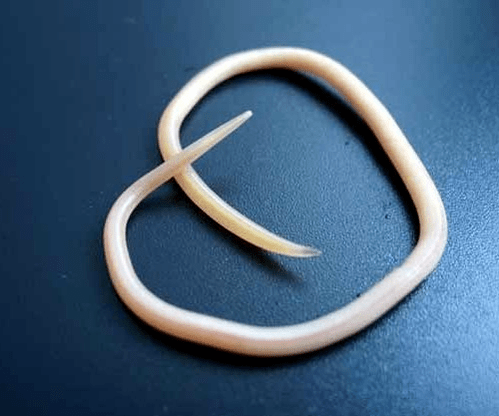
In the first days of the invasion, a person begins to feel nausea, irritability, fever, shortness of breath, cough and pain in the chest area. Such symptoms are justified by the fact that helminths initially affect the respiratory system.
Infection can occur from drinking raw water from unverified sources, poorly processed fresh fruits and vegetables. In summer, the risk of ascariasis is increased.
Stake worms
Small helminths that settle in the gut cause a disease called enterobiasis. Worms lay eggs in the anal area. The laid eggs turn into larvae and can re-enter the body only through the oral cavity.
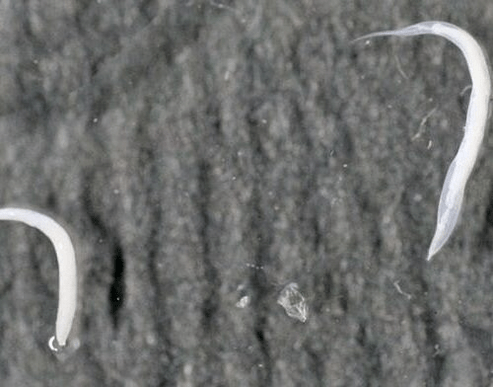
Re-infection occurs due to the contact of the dirty hands of a person suffering from enterobiasis with the food he eats. Symptoms of infection may include itching around the anus and increased irritability.
Important! The disease is transmitted by humans.
Bracelets
Infection with worm infection occurs through damaged skin in contact with the soil where the larvae of these types of worms live.
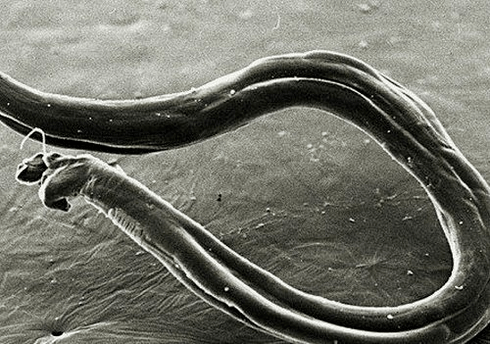
Hookworms, before entering the gut, follow the same path as roundworms.
Symptoms include coughing, lower abdominal pain, nausea and bowel movements. This type of helminthiasis can cause anemia.
Giardia
Giardiasis progresses in people who are accustomed to biting nails and other objects (pencils, pens). Infection can also occur in the case of drinking poor quality water, unwashed products, contact with contaminated laundry, where there may be larvae, and a carrier of the disease.
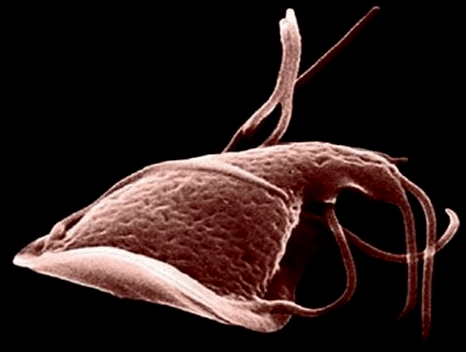
Symptoms of infection may include loose stools and pain in the lower abdomen.
Vlasoglava
Trichocephalosis occurs during infection with worm larvae. They are put inside along with raw fruits and vegetables. Hands and dirty water are also vectors.
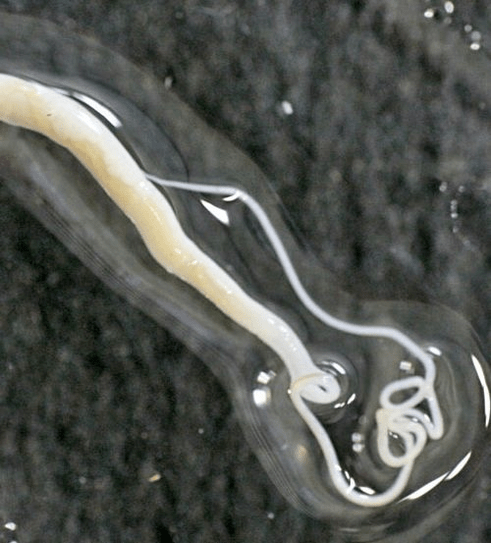
Invasion is accompanied by acute abdominal pain, diarrhea and decreased appetite. The signs of infection are often similar to those of appendicitis.
Dwarf ribbon
Worm infection occurs not only through dirty hands and unwashed food, but insects can also be carriers.
Dwarf tape affects the intestines and liver, causing inflammation and poisoning.
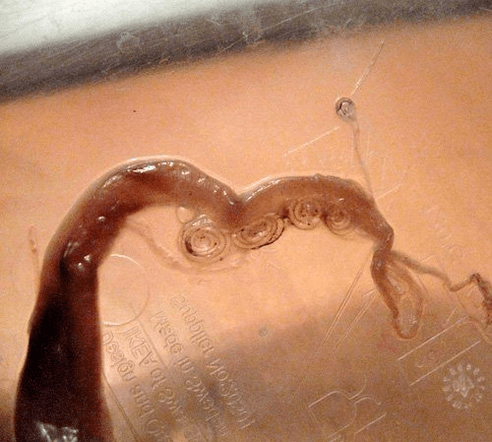
Hymenolepsia can be associated with the onset of dysbiosis, impaired appetite, increased thirst, fatigue and increased nervousness.
Cattle tape
One of the most dangerous types of worms that parasitize the colon.
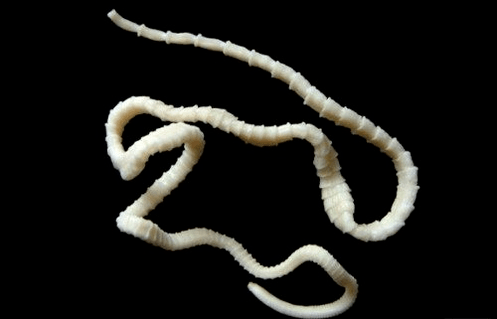
An adult worm reaches several meters in length. The individual removes all nutrients from the human body and produces severe intoxication.
Symptoms of invasion are:
- diarrhea and abdominal pain;
- vomiting and nausea;
- restless sleep;
- dizziness and fainting.
The risk of teniarinosis disease arises when you eat insufficiently processed beef contaminated with bovine tapeworm larvae.
Wide bar
The cause of difilobotriasis is the consumption of poorly processed fish products and caviar.
The worm that causes the disease is one of the largest and can reach ten meters.
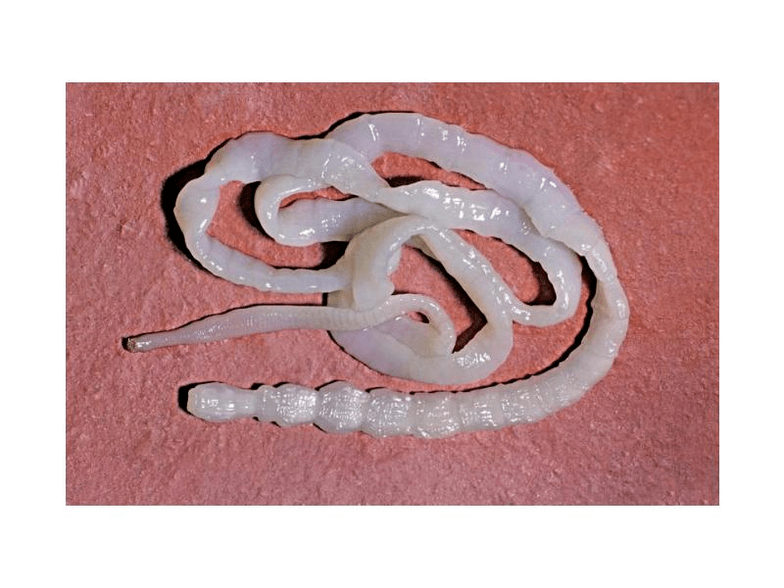
Symptoms of infection are severe lower abdominal pain and anemia.
Pork ribbon
Infection with this type of helminth is extremely dangerous to humans. Eating undercooked pork can cause Finns to enter the body and become adults.
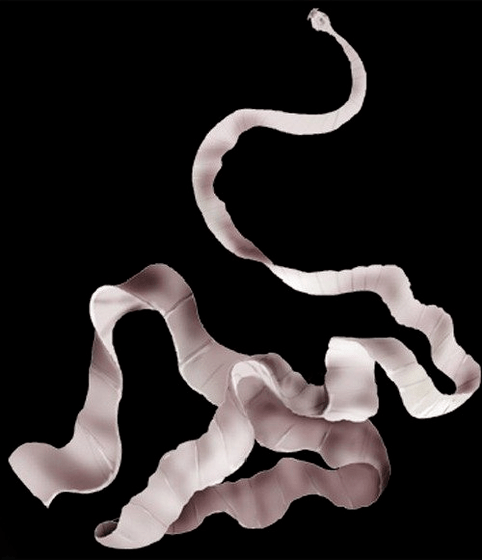
From the body of the pig strip, the so-called segments are periodically separated, which are able to leave the body itself through the anus or with the stool, entering the environment. The signs of teniasis are similar to those of bovine tapeworm infection.
Cysticerci
It is a type of tissue worm that is the product of a segment of pig strips. Segments containing striped eggs enter the external environment and may re-enter the body through external environmental objects and provoke the development of cysticercosis.
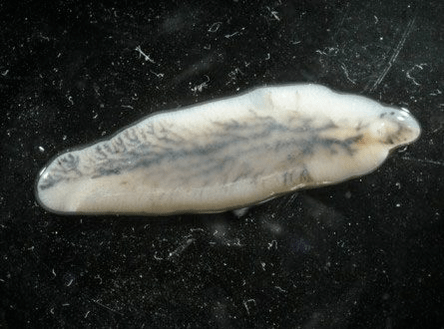
The parasites occupy the muscles, myocardium and even the brain.
Important! They have a squeezing effect on the organs and cause inflammation.
Hepatic streams
Opisthorchiasis occurs as a result of ingestion of hepatic lung larvae along with infected fish in the human body.
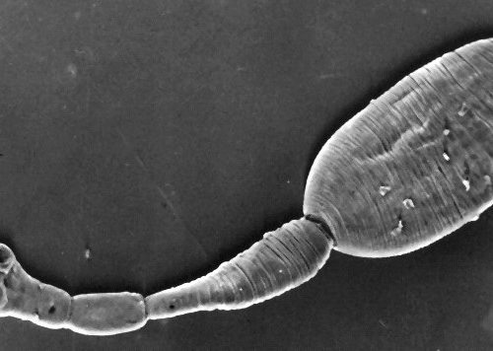
Signs of the presence of opisthorchiasis:
- mixed;
- diarrhea;
- pain all over the body;
- the appearance of allergies.
The most serious symptoms are chronic. This type of parasite is dangerous for the development of liver cancer.
Ekinokoku
The worm settles in the body, most often in the liver or lungs. Echinococcus can cause the formation of a cyst on the affected organ and the appearance of tumors. The infection can be fatal.
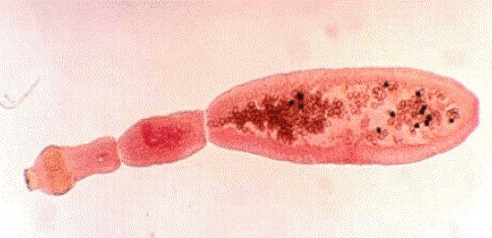
The larvae are transmitted to humans through contact with sick animals.
Trichinella
Trichinosis mainly affects people who eat poorly processed wildlife. Pigs can also be carriers of Trichinella.
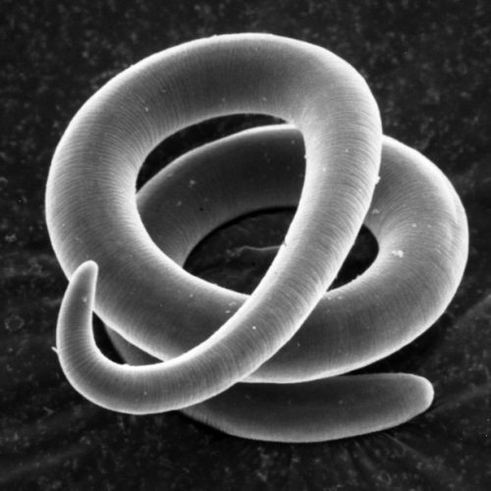
Adult habitats in the human body are different types of muscles (breathing, facial, etc. ).
At an early stage, loose nausea and defecation occur. Subsequent symptoms of invasion are fever, edema, skin rash, muscle aches. Infection with this type of parasite without timely treatment can be fatal.

Ways of human infection with helminths
- Biohelminthiasis (infection from animals).
- Contagious helminthiasis (transmitted from person to person).
- Geohelminthiasis (diseases caused by parasites that carry out one of their life cycles on earth).
Factors affecting the manifestations of helminthiasis
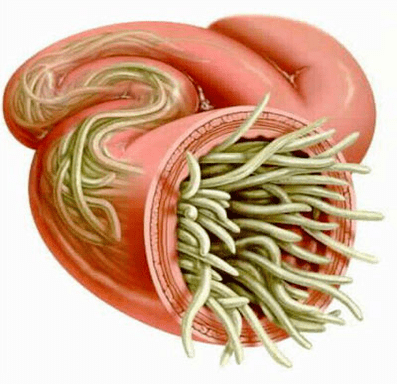
The way the parasite enters the body;
- The degree of adaptation of the helminth to the human body;
- Population density (number) of parasitic individuals;
- Worm habitat (tissue parasites live in soft tissue thickness, and luminal ones live in hollow organ cavities). Some helminths in different stages have luminal and tissue forms. The larval and developing stages of worms, as a rule, cause more pronounced pathological changes.
In the absence of re-infection, the number of adult parasites in the human body does not increase. This feature significantly distinguishes helminthic infestations from diseases caused by bacteria, viruses, fungi and protozoa.
Worms in humans: symptoms
Helminthiasis is a disease characterized by 2 stages of the course (acute, from two weeks to two months) and chronic (from several months to several years).
Symptoms of the acute phase of helminthiasis
The first signs of the disease can appear at different times (most often after 2-3 weeks, with ascariasis - after 2-3 days and with filariasis, the incubation period can last 6-18 months).
In the acute phase of parasitic invasion, the most characteristic symptom is an allergic reaction (antibodies are produced to antigens of migrating parasitic larvae). Often in people infected with worms, itchy rashes appear on the skin, prone to a recurrent course, regional lymph nodes, generalized or local edema, muscle and joint pain may occur. Also, larvae of migratory parasites can cause chest pain, coughing, choking attacks, bowel disorders, nausea and vomiting.
Signs of chronic helminthiasis
The symptoms of the chronic phase depend directly on which organ is "inhabited" by the parasites, and also their size and number play an important role.
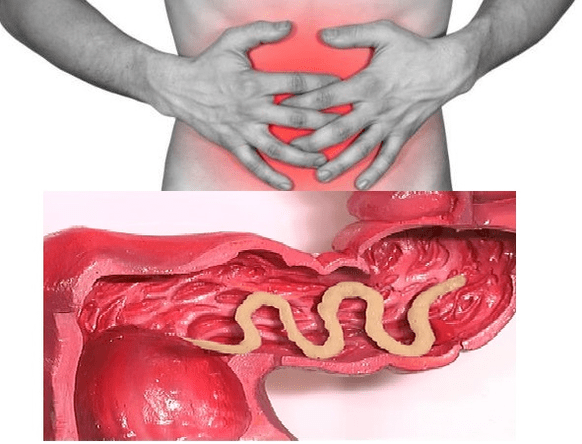
So when it parasitizes in the intestines of single individuals, the disease can be asymptomatic (except in cases of infection with very large parasites). Characteristic signs of the chronic phase of intestinal helminthiasis are dyspeptic disorders. In children, asthenoneurotic and pain syndrome is more pronounced. With the massive invasion of roundworms, the development of intestinal blockage, obstructive jaundice and pancreatitis is possible.
In people suffering from helminthiases, due to a weakened immune system and an enhanced process of cell division (as a result of continuous restoration of tissue damaged by parasites), the risk of malignant tumors increases significantly.
Types of helminths that parasitize the human body
The causative agents of human helminthiasis are 2 types of worms: roundworms (nematodes) and flatworms (tapeworms and streams).
Round worms
Needle worm
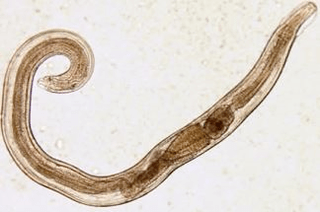
The parasites that cause enterobiasis are small worms (up to 10 mm) with a thin cavity with a white-gray coloration. Infection occurs edible (through the mouth). The reason for this is dirty hands. The parasite's eggs can be found in soil, in the fur of infected animals, unwashed vegetables and fruits, etc. At the same time, with enterobiasis, cases of self-infection are common (especially in children), resulting from scratching of the itchy areas and subsequent swallowing of eggs. The worm larva develops within two weeks in the digestive tract. Once it has turned into an adult, the worm parasitizes the lower parts of the small and upper parts of the colon.
Ascaris
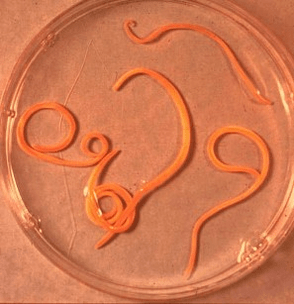
Ascaris is a large reddish-yellow, tail-shaped parasite that reaches 40 cm (females) and 15-25 cm (males) in adulthood. Without suction cups or other fixing devices, the roundworm is able to move independently towards food masses. Eggs laid by the female parasite are excreted along with the feces.
Vlasoglav
Vlasoglav, the causative agent of trichocephalosis, is a white helminth that parasitizes in the initial part of the colon and reaches a size of 4-5 cm. The parasite feeds on blood and tissues of the rectal mucosa.
With a small number of worms, trichocephalosis is asymptomatic. In a severe stage (with massive invasion), the patient develops abdominal pain, develops severe diarrhea, sometimes accompanied by rectal prolapse. This condition is more common in debilitated children. With a moderate stage of trichocephaly, delayed child growth is possible.
Trichinella
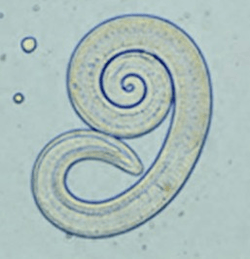
The causative agent of trichinosis is a small round helminth, reaching 2-5 mm in length. Infection occurs when you eat poorly cooked meat (pork, bear, wild boar). Penetrating into the intestines, the parasite larva matures in 3-4 days in the condition of a sexually mature individual. The lifespan of the worm is 40 days, after which the parasite dies. By piercing the intestinal wall, the larvae enter the bloodstream and are carried to all organs of the human body, settling in the muscles. In this case, the respiratory and facial muscles, as well as the flexor muscles of the limbs, are affected more often.
In the first days after the invasion, patients complain of colic. Then, after about 2 weeks, the body temperature rises to 39-40 C, itchy rashes appear on the skin, muscle pain develops and the face swells. During this period, in case of mass infection, there is a considerable risk of death. After about a month, the patient recovers. The parasite encapsulates in a spiral shape, after which it dies within two years.
Bracelets and nectar
These two parasites are similar in biological characteristics as well as in diseases caused. In this regard, it is customary to combine them under a common name (ship worms). Worms, reaching a length of 10-15 mm, parasitize at 12-p. intestineIt should be noted that this is one of the most common parasites, but, at the same time, very rare. Worm larvae enter the human body through the skin after contact with contaminated soil. Further, entering the bloodstream, they, like roundworms, migrate to the lungs and then, through the bronchi, along with expectorant saliva, into the digestive tract. Ankilostoma parasitizes in the intestine, attaching to the intestinal wall. Therefore, the most characteristic symptom of this helminthiasis is iron deficiency anemia, as well as a change in the ratio of protein fractions (dysproteinemia).
Flatworms
Wide bar
This is one of the largest helminths, reaching a length of 10-20 meters. The disease caused by this parasite is called difilobotriasis. The worm development cycle begins with freshwater fish or crustaceans. The larva enters the human body, which is the ultimate owner of the broad strip, along with the infected fish eggs or fillets. Reaching the small intestine, the parasite clings to its wall and grows in a mature individual within 20-25 days.
Diphyllobothriasis occurs against the background of digestive tract disorders and B12 deficiency anemia.
Hepatic streams
The parasite that causes opisthorchiasis is a flatworm that reaches a length of 7-20 mm. Human infection occurs when you eat contaminated fish meat that has not undergone sufficient heat treatment. The larva of hepatic fat from the small intestine penetrates the bile ducts and gallbladder, being fixed there with the help of two suction cups.
In the acute stage of helminthiasis, the patient has soreness in the upper abdomen, body temperature rises, nausea, muscle pain develops, diarrhea and skin rashes are possible. The chronic course of opisthorchiasis is manifested by symptoms of hepatitis, inflammation of the bile ducts, cholecystitis, disorders of the digestive tract, nervous disorders, weakness and increased fatigue. The parasite leads to the development of irreversible changes, and even after its expulsion, the patient does not undergo chronic inflammatory processes and functional disorders.
Cattle and pork ribbon
These parasites, almost identical in structure, reach a length of 5-6 meters. Infection with teniarinosis and teniasis occurs due to consumption of meat from cattle or pork infected by Finns (one of the intermediate forms of helminthiasis). Stable Finns, presented in the form of white bubbles reaching the size of 0, 5 cm, attach to the wall of the human small intestine and turn into an adult in 3 months. The tapeworm, consisting of more than 2000 segments, is constantly growing.
Ekinokoku
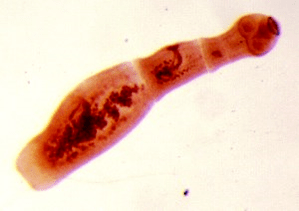
For this parasite, a person is an intermediate host. The worm parasitizes the human body in the form of Finns. The ultimate owner of the echinococcus is a wolf, dog or cat. Infection occurs through food contact with animals and environmental objects planted with Echinococcus eggs. After entering the intestine, oncospheres (larvae with six hooks) develop from them. From the intestines, they enter the bloodstream and are carried throughout the body.
Alveokoku
This parasite, considered a type of echinococcus, is the cause of one of the most dangerous helminthiases (alveococcosis), which is similar in severity to cirrhosis and liver cancer. Infection occurs when oncospheres (eggs with mature larvae) penetrate the intestines. Laurocysts are very aggressive formations that grow continuously due to bubble enlargement, and also have the ability to grow in the liver, like cancer metastases. Necrotic changes due to disturbances in the functioning of blood vessels undergo necrotic changes in nearby tissues. Propagated in nearby structures, alveococcus forms fibrous nodules involving multi-chambered bubbles. This condition can last for several years, so it requires mandatory surgical intervention.
Diagnosis of helminthiasis
Diagnosing helminth infestations includes the following activities:
- careful collection of medical history, which helps to find out the possible causes of the infection;
- laboratory tests of feces, blood, intestinal contents 12p, rectal and perianal mucus, muscle tissue, pulmonary saliva, bile. The analysis can detect eggs, segments or fragments of parasites. At the same time, an increased content of eosinophils in the blood is also a signal of the presence of helminthiasis.
- when diagnosing diseases caused by larval stages or tissue parasites, serological tests are performed (ELISA, RSK, indirect agglutination reaction, immunofluorescence analysis, etc. ).
- to identify worms affecting liver tissue, ultrasound, CT, and endoscopic studies are prescribed.
Worms in humans: treatment
In the acute phase of parasitic infection, the patient is prescribed detoxification and desensitizing therapy. In severe cases of the disease (liver trematodes, trichinosis), glucocorticoids are used according to medical indications.
Specific anthelmintic chemotherapeutic agents are prescribed as specific therapy drugs, taking into account the nature of the pathogen.
In parallel, the patient is recommended to take antihistamines and enterosorbents. The final stage of treatment involves the use of probiotics that normalize the intestinal microflora.
Diet A special mild diet is also prescribed (food should be digestible and low in fat).
During the period of anthelmintic therapy, the patient is required to strictly observe personal hygiene (to avoid re-infection). At the same time, for many helminths, all family members and persons who are in constant contact with the infected should undergo treatment.
An underestimation of their risk, combined with a lack of awareness of the biology of these creatures and ways of infecting them, has led to the fact that at least several billion people are now carriers of certain parasites.
Parasites can also be present not only inside a person but also outside the human body.
Prevention of parasitic infection
Rule # 1:you can not eat anything from fish that is not salty, fried or boiled enough. Sushi, lightly salted herring or sashimi can be considered gourmet food. But it is basically a living fish, and fish is one of the components of the life cycle of parasitic worms.
How everything happens:first, the larva enters the mollusk, where it does not grow more than a certain limit, then the fish eats the mollusk, the larva enters its digestive tract, staying alive, then grows and multiplies, entering the muscle tissue of the fish, thenthis fish is eaten by a dolphin, gull or polar bear. Or a restaurant visitor who decides to join the high Japanese culture.
Safe raw fish exists in theory. To do this, it must be frozen immediately after catching and thawed shortly before cooking, or it must be specially grown on a fish farm with parasite control. But it is usually impossible to check if a dangerous dish is really prepared from it.
The same care must be taken with meat; do not try raw minced meat and freshly salted bacon.
In addition, to avoid being infected with helminths, vegetables should be washed before eating, as well as hands. As a component of the natural environment, these parasites in the human body are found almost everywhere.
Any contact of food or hands with soil, unclean dust and vegetation can leave their microscopic eggs in the food. If they enter the intestine, the worms will hatch from the eggs, which will not be easy to remove.
There are parasites that attack a person who walks or relaxes in nature, for example:
- malaria plasmium, contained in the saliva of mosquitoes of the genus Anopheles,
- the causative agent of encephalitis contained in the saliva of iodide ticks,
- fly gadfly and wolf.
Their prevention consists in the use of all kinds of detergents for walks in the wild, as well as in the maximum protection of open areas of the body (mosquito nets, nets, special gels).
However, what can you do if prevention has not helped? Since the attack has been known for a long time, treatment with popular methods has also been known for a long time.
And in conclusion, it can be observed that adhering to simple rules of hygiene and hygiene, extermination of flies and cockroaches, can significantly reduce the risk of infection with parasites, leading to serious consequences.
























